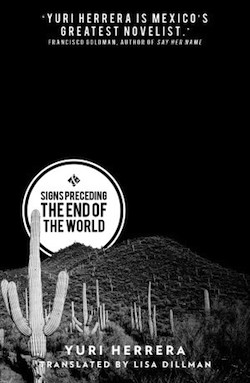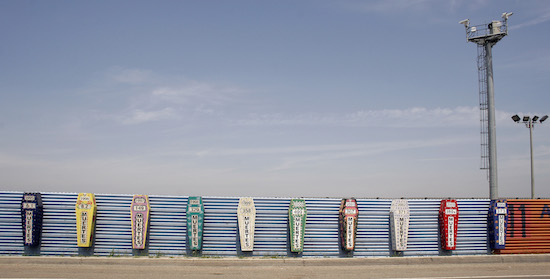Since Berlin’s been unified, and the New Cold War hasn’t yet drawn any definitive iron curtains, it’s still a good bet that the US-Mexican border is the most mythologised in the world. It’s a place you probably feel you know quite well, whether or not you’ve been closer than Disneyworld: Anglophone culture supplies a rich haul of narco-trafficking thrillers, neo-Westerns, pornographic news reports and big chewy macho novels about violence which take as their setting that parched strip of land between Baja California and the Gulf of Mexico. This is the cultural imaginary with which the US, and by default the rest of the English-speaking world, tries to come to terms with the two-thousand-mile frontier along which it faces the world it’s been conquering, plundering, repressing and habitually shitting on for the past few centuries.
Reading Yuri Herrera’s novel Signs Preceding the End of the World – criminally, his only full-length work currently available in English – makes you realise how impoverished and crooked that imaginary is; how the narratives you’ve been consuming actually pullulate with the kinds of fear, hatred, desire and disgust surrounding the Other that, as good post-colonialists, we’re supposed to find embarrassing. Above all it makes you realise that most border fiction – all those novels and TV series and films – are as much a part of that border’s malign machinery of terror and exclusion as the fences, the helicopters, the bureaucracy and the border patrols.
McCarthy, of course, looms over this cultural territory like a craggy mesa, parched and austere and not given to kindness. For him the borderlands are where prophets of doom wreak havoc, where the peasants are cowed and filthy, where quietly charismatic cowboys exercise a pained decency in the face of the inhuman and learn valuable lessons about God and horses. It’s a landscape where men are either eloquently evil or possessed of a taciturn Texas grit, where women are either faithless hellcat whores or loyal, innocent, ductile, doomed housewife Madonnas. It’s the source of the satanic energies that destroy decent Llewelyn Moss and defeat stolid Sheriff Ed Tom Bell in No Country for Old Men, and induce Cameron Diaz in The Counselor to frot herself silly on a big shiny car.
In Breaking Bad, Mexico is where the bogeymen come from: psychopathic narcos with their bullish shoulders and hair-grease, Tortugo with his cackling venality and childish hunger for consumer goods (Danny Trejo’s face itself a crumbling pre-Columbian monument, jungle-mysterious, marketably Other), and those otherworldly twins that turn up in immaculate snakeskin boots to do silent murder. These aren’t humans so much as folk devils, tricked out in the troubling colours of minstrelsy.
There’s a longish genealogy behind this kind of thing. Malcolm Lowry’s Under the Volcano builds much of its dodgy metaphysical scaffolding on the implicit understanding that Mexican culture is in some way imbued with a thanatic charge, an intimacy with death – the dancing skeletons, the booze and derangement, the double madness of idolatry and Catholicism, the spectre of fascism – all of it, to the cultured Protestant Anglo, both vicarious thrill and potential seduction. And in Hispanophone writing that’s made it big in translation, there’s often the sense—never necessarily the fault of the writer—that the work’s success has something to do with its receptivity to those tropes. When Roberto Bolaño’s 2666 hit the shelves and the bestseller lists, what attracted the most attention was its obsessive anatomisation of the violence visited against women in Ciudad Juárez. Sex, death, sadism, the pornographic gaze; cruelties both intimate and systemic, taking place in desert and maquiladora, perpetuated by an elite that’s always more cartoonishly vulgar and evil than our own: these are what we expect from our border fictions, and by God we’re going to get them.
The general drift, anyway, is clear. The borderlands are hell: a contact zone between the known and the unknowable, order and disorder, upright protestant restraint and mad catholic/pagan frenzy, life and death. They’re where rational, puritan America confronts its dark twin, a terra incognita from which monstrous shapes emerge, where the rules are unclear and uncanny transformations take place. They throb with sex and danger and transgressive thrills.
Signs Preceding the End of the World flips this map. In Herrera’s short, brutal, urgent missive of a book, it’s Mexico that’s the known world, and the country to the North that’s dark and threatening. It’s essentially a quest novel, in which a young Mexican woman, Makina, leaves her village to travel north in search of her disappeared brother. She has to ask for the blessing and the help of local gangsters, who dole out packages for delivery along with gnomic advice. Once she’s taken a bus to the border, travelling through a country depopulated of men, she must entrust herself to the coyotes, the people-smugglers who cross the Rio Grande on inner tubes and shepherd immigrants across a desert borderland patrolled by vigilantes and crooked cops. And then, of course, she has to pursue a passage through the uncanny underworld of the undocumented citizen in the US.
The first thing she sees on the other side is a pregnant woman resting under a tree, who turns out to be a dead man, bloated in the sun, with his eyes and tongue pecked out by vultures: a reversed version of the initiation into violence and danger that usually marks the trip south in Anglo border fictions. She nearly drowns; she gets shot; she keeps going. She’s hard and funny and resourceful and sad. When she makes it to the unnamed city where she hopes to find her brother, it’s not a place at all, but a concrete and steel plain, a nameless tundra whose inhabitants engage in incomprehensible rituals: “Signs prohibiting things thronged the streets, leading citizens to see themselves as ever protected, safe, friendly, innocent, proud, and intermittently bewildered, blithe, and buoyant; salt of the only earth worth knowing.” This America is a bleak ultima thule where it’s always cold and where the chances of mercy or shelter are slim. There’s a moment in a sports stadium where she must hand over a package to a gangster: the encounter is oneirically weird, the stadium invested with the vertiginous terror of a Mayan pyramid, and the handover teetering at every moment on the verge of sacrificial violence: it becomes clear that, for Makina and perhaps for Herrera as well, we are already at the end of the world.
Which leads us back, depressingly, to McCarthy. In a way, bringing up McCarthy with reference to Herrera is what literary critics call a dick move: why read the work of a great Mexican writer through the work of a minor American one? But assuming you’re going to be reading Signs Preceding in English translation, it’s hard not to be reminded of him at moments like that sports-stadium handoff. Herrera’s prose, as translated by Lisa Dillman, has some of McCarthy’s doomy intonations, his terse impressionism, and his obvious debts to Beckett, Hemingway and Faulkner: in Dillman’s translator’s note at the end of the book (which is well worth reading), she names McCarthy as an important influence. There’s the same sense, as in Blood Meridian or The Road, of the central journey taking place in a kind of permanent apocalyptic haze where life and soul are constantly at stake and every sunset is terminal. There’s the same nervy hovering around the edge of allegory and never quite committing to the jump. And the landscape, of course, is the same: once translated, like it or not, Herrera’s work must contend with the macho imaginary with which we, dumb Anglos, can’t help but mediate that setting.
But Herrera is—well—better. Where McCarthy writes pulp Westerns dressed up in prettily portentous sentences and cod-profound metaphysics, Herrera writes literature. Signs Preceding packs a fractal complexity into its furiously concentrated sentences; it’s slangy, impish, iterative, slightly manic even at its saddest. Herrera has everything McCarthy doesn’t: humour, kindness, politics that don’t stink.
But what sets him permanently apart from the majority of Anglo border fictions, and gives the most reason to hope that his work will make us understand these borderlands (and others, come to that) more clearly, is that it’s fundamentally not about what they’re about. At the bottom of most border writing, there’s a fantasy of encounter in which nothing is really at stake in terms of selfhood and identity. McCarthy’s heroes might speak Spanish and sleep with Latina women, they might get killed at the end or they might not, but they remain inviolately and irreducibly American. Walter White becomes a lot of things that the Mexicans in Breaking Bad might also be—cunning, duplicitous, amoral—but in no way does he become one of them. The bearers of the masculine Anglo virtues can be destroyed, but the virtues themselves are indestructible. These fictions are basically defensive: they want us to believe that, frightening as it is to have to share the world with people different from ourselves, we don’t have to be compromised by it, and can remain unpolluted up to and beyond the moment of death.
Herrera shows this up for the reactionary, nativist bullshit that it is. Signs Preceding isn’t about drawing borders more firmly, but about crossing them, surviving them, assimilating them. In the US, Herrera’s immigrants signal to each other from doorways, make brief eye-contact in the street, offer tenuous solidarity in back rooms and kitchens. They embrace cultural hybridity and are estranged from themselves by it; they lose each other to adoptive languages. They struggle to hold on to a version of themselves that preceded their border crossing, and generally fail. Rather than offer a fantasy of cultural purity in the face of exterior threat, Signs Preceding depicts the mobility – geographical, cultural, linguistic – of global citizens, and the loss that goes with it.
This isn’t a hopeful vision, and Herrera isn’t selling a bland multiculturalist utopia: he’s just saying how it is, and how it’ll continue to be, for the billions of people against whom borders are erected, and for whom they’re obstacles to be crossed – often at enormous existential risk – rather than lines to be defended. Without going too deeply into what happens at the end – let’s say the book severs its last ties with realism, and there’s a certain ambiguity, but not in a way that constitutes any kind of cop-out – Signs Preceding closes with a vision of immigration as erasal. New papers mean a new name and a new self. You can never go home again; there’s no-one left to return to the range or ride into the sunset. The frontier, in the border fiction of the new century, is inside.



